Traffic lights, beetles and dung…you’re probably wondering where this article is going. It’s not an ode to The Beatles’ Abbey Road album cover, but a strategy to combat the loss of wormers of which there are only three options left for use in livestock production.
Bruce Thompson is milking 330 cows in Co Laois. In early December, the Irish Farmers Journal visited and the heifers were grazing happily at the foot of the Slieve Bloom Mountains.
Bruce is now somewhat famous for his work on dung beetles. He completed a Nuffield scholarship this year and his focus is on reducing the use of anthelmintics, or wormers as they’re more commonly known, and indeed other medicines on farm.
To be clear, Bruce uses wormers on his farm, but he fears these products will be lost if resistance buildup continues and he is actively trying to reduce their use. 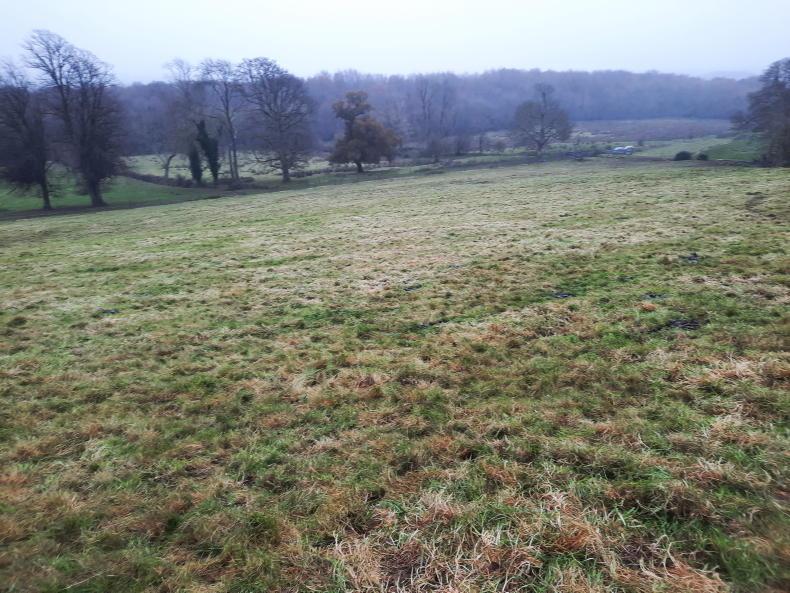
The dung pads were broken down by dung beetles and earthworms and there were no tufts of grass left behind.
He maintains that 20% of the animals on farms are responsible for 80% of the parasites, so this is something he is working on.
When it comes to wormers he notes that he will “use as much as necessary, but as little as possible”. This may result in some animals receiving no wormer at all, while others may require regular application.
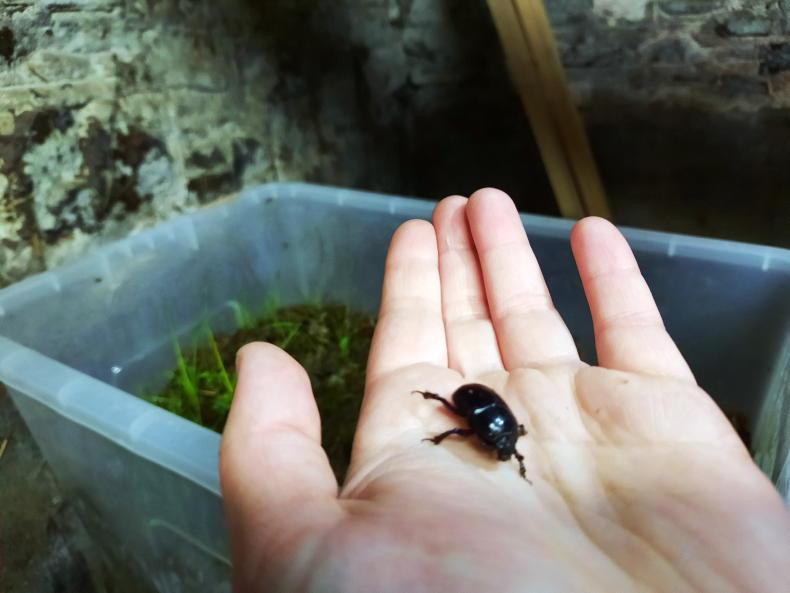
A dung beetle on Bruce Thompson's farm in Co Laois.
As we look out on a group of heifers, Bruce says that 30% of the batch have never received a wormer, while a small number in the group may have received six or seven wormers.
He is working on building resistance into his herd and the first step along the way is the traffic light system, something that many farmers can look at implementing on the farm. In order to reduce dependence on these products animals must build up resistance. There are two types of resistance – the one the animal is born with (innate) and the resistance the animal builds up (adaptive).
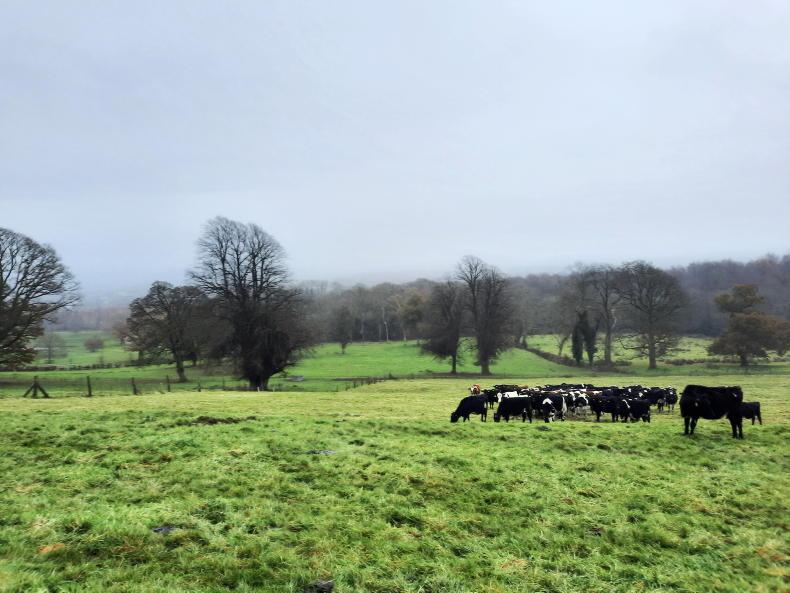
Heifers grazing. They are moved regularly and water troughs are also moved as part of the system on the farm.
Adaptive is the one that the traffic light system is focused on with the fastest payback and it starts from the time calves are let out to grass.
Traditionally, calves are often let out to the paddock near the farmyard or perhaps even the field beside the calving shed, but if we think about this, we are exposing calves to pasture which has been grazed continuously by young animals with very little immunity and the parasite load is most likely high.
Bruce has mapped his farm according to the assumed parasitic loading from the level of larval contamination, so instead of going to a training paddock the calves go to a “green” paddock which has a low level of parasites. The traffic light system sees these animals move after three days.
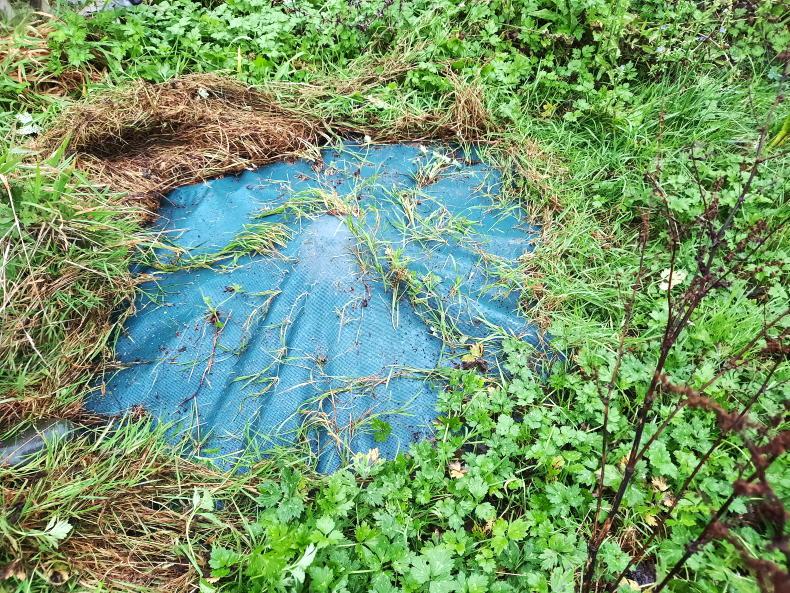
A breeding tent on the farm.
Water troughs in these paddocks are also moved every time the animals enter the paddock as parasite numbers can be very high where animals congregate.
Calves are allocated green paddocks, while other animals will take the orange and red paddocks and immunity is built up by exposing these calves to an orange paddock at an older age, as animals build immunity when they are exposed to the parasite.
Over the past few years, Bruce was focused on increasing cow numbers
During the summer, green paddocks will not always be available and young stock will move to orange paddocks.
Over the past few years, Bruce was focused on increasing cow numbers.
He is now focused on increasing immunity in his herd so, for example, if some of the replacement heifers leave the farm they will most likely be those which were treated more regularly with a wormer.
This will help to build up the herd’s overall immunity over time.
Bruce carries out the faecal egg counts himself. He has a microscope on the farm and as he has such a keen interest in the subject he has a lab set up, but he notes that farmers can send faecal samples away to be tested and noted how this is common practice on so many sheep farms.
When to dose?
Bruce carries out faecal egg counts and if he counts 250 eggs or more in a dung pad animals are brought in and weighed. If they are not adding 0.7kg/head/day they are treated with a wormer.
Other signs like a dirty tail or dung with a high liquid content would also trigger the administration of a wormer.
Bruce is very clear that if an animal needs a wormer it will get it and in order to prevent resistance build up in these products, it will be applied at the correct rate and products will be alternated between the three available – benzimidazoles, levamasole and macrocyclic lactones.
Once treated with a wormer, these animals are sent to a specific area of the farm for 48 hours. This is because if the products kill 95% of the parasites, the 5% of the parasites left over are hardy and may have some resistance to these products.
Leaving these animals on a specified paddock used after worming helps to water down the 5% of genes with resistance to these products. After 48 hours, the animals move to an orange or red paddock, but they will not go to a green one as the population could become infected with resistant parasites.
Dung beetles
The next step on the journey to reduce dependence is by using dung beetles. In a nutshell, the dung beetle sucks the moisture out of dung pads in the field. They feed on the bacteria. Once the dung pad is dried out, earthworms will feed on the manure and bring it into the soil.
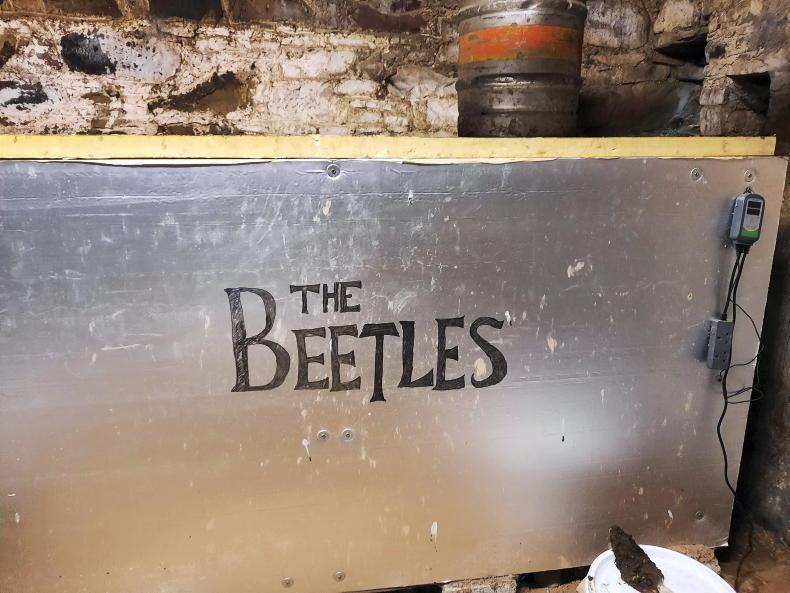
Bruce is trying to multiply 80 dung beetles to 8,000 by the summertime.
This helps to stop the 21-day lifecycle of the parasite while also helping to improve soil biology and organic matter.
As we look across the paddock, it’s very noticeable that there aren’t big tufts of grass where there was animal dung. This is because the dung pads are broken down quickly, so grass utilisation is also being improved as a result.
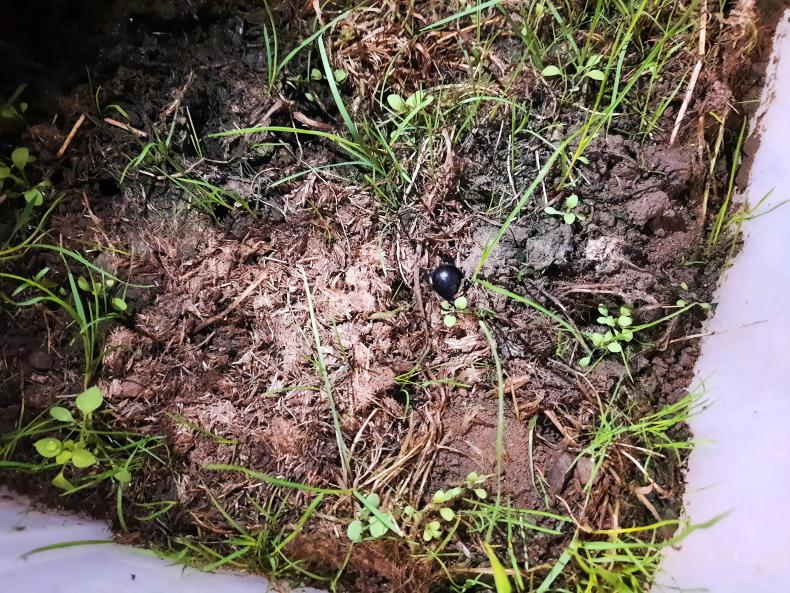
A tunnelling dung beetle on Bruce Thompson's farm.
While there are dung beetles in Ireland they aren’t abundant and Bruce works hard to increase populations.
Back at the farmyard, Bruce has containers of soil with beetles and a large container which has soil from the farm where the temperature is controlled.
Eighty dung beetles were placed in this environment and Bruce hopes this number will grow to 8,000.
When numbers increase, they will be placed in breeding tents out in the field and will migrate out to the fields nearby and through the farm.
Bruce is trying to increase the number of tunnelling dung beetles, which he says are declining in numbers.
These beetles are particularly important for tunnelling into the soil and helping with soil structure.
Fly treatments haven’t been used for a few years on the farm
The use of synthetic pyrethroids and products to control flies can have an impact on these numbers and this is another reason why Bruce is reducing use. Fly treatments haven’t been used for a few years on the farm, but alternatives like Stockholm tar or eucalyptus oil have been used.
European Innovation Partnership
Earlier this year, Bruce’s local discussion group – the O’Moore Discussion Group – was awarded a grant for a European innovation Partnership to implement the traffic light system on a number of farms in the group.
Bruce will use his research and experience from his own farm to help members of the group to adapt to these practices.
Implementing
best practice
Many of the practices Bruce is implementing on his farm can also be implemented on many other farms.
A simple step such as taking faecal samples to decide on the parasite risk is a start.
Sending calves to a fresh paddock can also help to reduce incidence of worms, while moving the water troughs is an effective way of preventing high levels of parasite loading in one area of the field. These steps are relatively easy to implement on farm.
Weighing animals and determining the need for a wormer based on weight gain is a practical step to take.
While breeding dung beetles will be a stretch for many, in order to change on your farm the simple steps above are a great start to make.
Bruce is trying to reduce the use of wormers on his farm, as well as other medicines such as pour-ons for flies.He is trying to build the immunity of his herd to these parasites.He takes faecal samples to determine parasite loading.He is breeding dung beetles to reduce parasite levels and to improve soil health and structure. He is saving money. Spend on wormers, lice and fly treatments has been reduced by 78%.
Traffic lights, beetles and dung…you’re probably wondering where this article is going. It’s not an ode to The Beatles’ Abbey Road album cover, but a strategy to combat the loss of wormers of which there are only three options left for use in livestock production.
Bruce Thompson is milking 330 cows in Co Laois. In early December, the Irish Farmers Journal visited and the heifers were grazing happily at the foot of the Slieve Bloom Mountains.
Bruce is now somewhat famous for his work on dung beetles. He completed a Nuffield scholarship this year and his focus is on reducing the use of anthelmintics, or wormers as they’re more commonly known, and indeed other medicines on farm.
To be clear, Bruce uses wormers on his farm, but he fears these products will be lost if resistance buildup continues and he is actively trying to reduce their use. 
The dung pads were broken down by dung beetles and earthworms and there were no tufts of grass left behind.
He maintains that 20% of the animals on farms are responsible for 80% of the parasites, so this is something he is working on.
When it comes to wormers he notes that he will “use as much as necessary, but as little as possible”. This may result in some animals receiving no wormer at all, while others may require regular application.

A dung beetle on Bruce Thompson's farm in Co Laois.
As we look out on a group of heifers, Bruce says that 30% of the batch have never received a wormer, while a small number in the group may have received six or seven wormers.
He is working on building resistance into his herd and the first step along the way is the traffic light system, something that many farmers can look at implementing on the farm. In order to reduce dependence on these products animals must build up resistance. There are two types of resistance – the one the animal is born with (innate) and the resistance the animal builds up (adaptive).

Heifers grazing. They are moved regularly and water troughs are also moved as part of the system on the farm.
Adaptive is the one that the traffic light system is focused on with the fastest payback and it starts from the time calves are let out to grass.
Traditionally, calves are often let out to the paddock near the farmyard or perhaps even the field beside the calving shed, but if we think about this, we are exposing calves to pasture which has been grazed continuously by young animals with very little immunity and the parasite load is most likely high.
Bruce has mapped his farm according to the assumed parasitic loading from the level of larval contamination, so instead of going to a training paddock the calves go to a “green” paddock which has a low level of parasites. The traffic light system sees these animals move after three days.

A breeding tent on the farm.
Water troughs in these paddocks are also moved every time the animals enter the paddock as parasite numbers can be very high where animals congregate.
Calves are allocated green paddocks, while other animals will take the orange and red paddocks and immunity is built up by exposing these calves to an orange paddock at an older age, as animals build immunity when they are exposed to the parasite.
Over the past few years, Bruce was focused on increasing cow numbers
During the summer, green paddocks will not always be available and young stock will move to orange paddocks.
Over the past few years, Bruce was focused on increasing cow numbers.
He is now focused on increasing immunity in his herd so, for example, if some of the replacement heifers leave the farm they will most likely be those which were treated more regularly with a wormer.
This will help to build up the herd’s overall immunity over time.
Bruce carries out the faecal egg counts himself. He has a microscope on the farm and as he has such a keen interest in the subject he has a lab set up, but he notes that farmers can send faecal samples away to be tested and noted how this is common practice on so many sheep farms.
When to dose?
Bruce carries out faecal egg counts and if he counts 250 eggs or more in a dung pad animals are brought in and weighed. If they are not adding 0.7kg/head/day they are treated with a wormer.
Other signs like a dirty tail or dung with a high liquid content would also trigger the administration of a wormer.
Bruce is very clear that if an animal needs a wormer it will get it and in order to prevent resistance build up in these products, it will be applied at the correct rate and products will be alternated between the three available – benzimidazoles, levamasole and macrocyclic lactones.
Once treated with a wormer, these animals are sent to a specific area of the farm for 48 hours. This is because if the products kill 95% of the parasites, the 5% of the parasites left over are hardy and may have some resistance to these products.
Leaving these animals on a specified paddock used after worming helps to water down the 5% of genes with resistance to these products. After 48 hours, the animals move to an orange or red paddock, but they will not go to a green one as the population could become infected with resistant parasites.
Dung beetles
The next step on the journey to reduce dependence is by using dung beetles. In a nutshell, the dung beetle sucks the moisture out of dung pads in the field. They feed on the bacteria. Once the dung pad is dried out, earthworms will feed on the manure and bring it into the soil.

Bruce is trying to multiply 80 dung beetles to 8,000 by the summertime.
This helps to stop the 21-day lifecycle of the parasite while also helping to improve soil biology and organic matter.
As we look across the paddock, it’s very noticeable that there aren’t big tufts of grass where there was animal dung. This is because the dung pads are broken down quickly, so grass utilisation is also being improved as a result.

A tunnelling dung beetle on Bruce Thompson's farm.
While there are dung beetles in Ireland they aren’t abundant and Bruce works hard to increase populations.
Back at the farmyard, Bruce has containers of soil with beetles and a large container which has soil from the farm where the temperature is controlled.
Eighty dung beetles were placed in this environment and Bruce hopes this number will grow to 8,000.
When numbers increase, they will be placed in breeding tents out in the field and will migrate out to the fields nearby and through the farm.
Bruce is trying to increase the number of tunnelling dung beetles, which he says are declining in numbers.
These beetles are particularly important for tunnelling into the soil and helping with soil structure.
Fly treatments haven’t been used for a few years on the farm
The use of synthetic pyrethroids and products to control flies can have an impact on these numbers and this is another reason why Bruce is reducing use. Fly treatments haven’t been used for a few years on the farm, but alternatives like Stockholm tar or eucalyptus oil have been used.
European Innovation Partnership
Earlier this year, Bruce’s local discussion group – the O’Moore Discussion Group – was awarded a grant for a European innovation Partnership to implement the traffic light system on a number of farms in the group.
Bruce will use his research and experience from his own farm to help members of the group to adapt to these practices.
Implementing
best practice
Many of the practices Bruce is implementing on his farm can also be implemented on many other farms.
A simple step such as taking faecal samples to decide on the parasite risk is a start.
Sending calves to a fresh paddock can also help to reduce incidence of worms, while moving the water troughs is an effective way of preventing high levels of parasite loading in one area of the field. These steps are relatively easy to implement on farm.
Weighing animals and determining the need for a wormer based on weight gain is a practical step to take.
While breeding dung beetles will be a stretch for many, in order to change on your farm the simple steps above are a great start to make.
Bruce is trying to reduce the use of wormers on his farm, as well as other medicines such as pour-ons for flies.He is trying to build the immunity of his herd to these parasites.He takes faecal samples to determine parasite loading.He is breeding dung beetles to reduce parasite levels and to improve soil health and structure. He is saving money. Spend on wormers, lice and fly treatments has been reduced by 78%. 











 This is a subscriber-only article
This is a subscriber-only article
















SHARING OPTIONS: